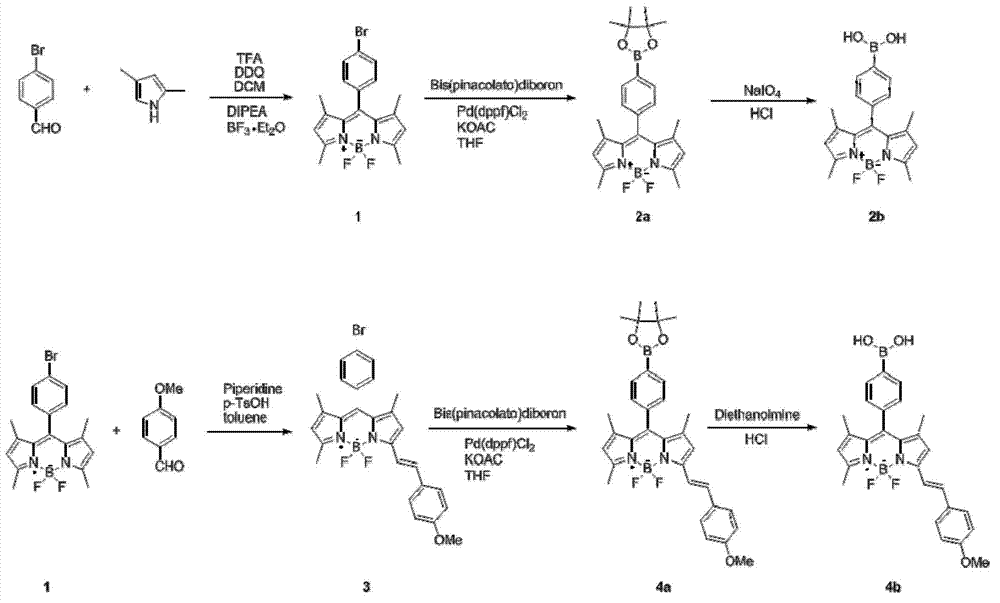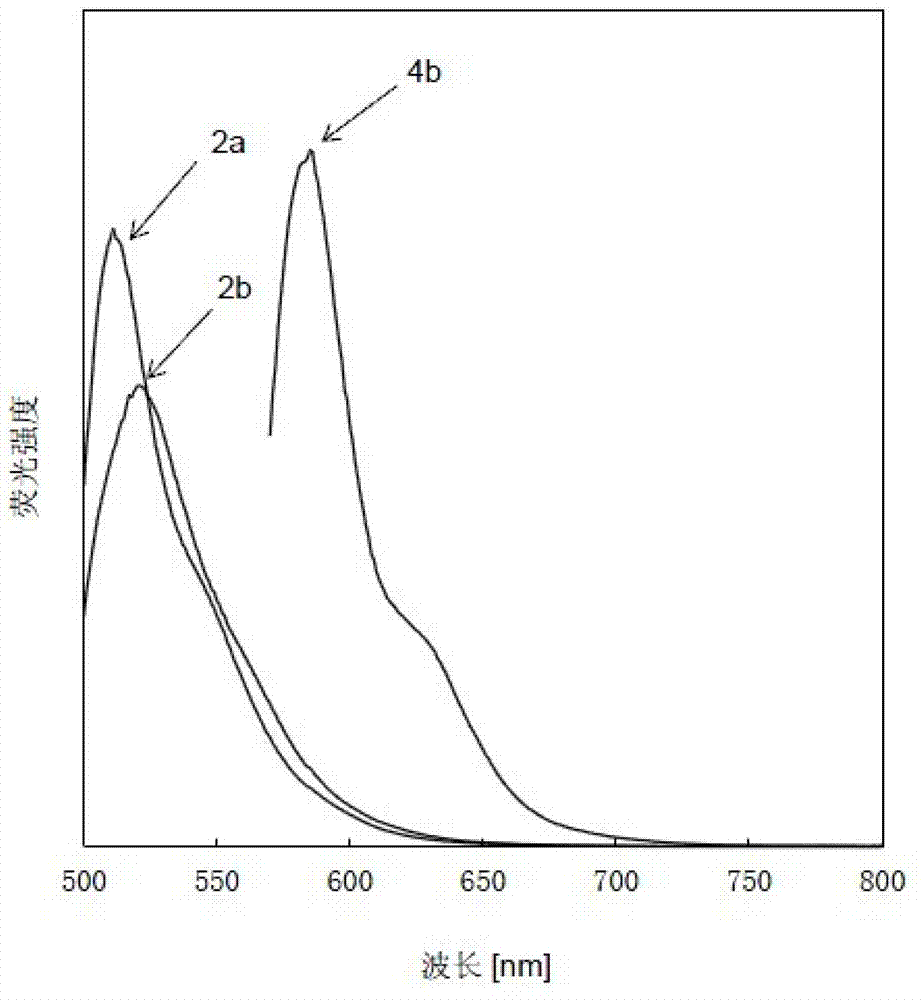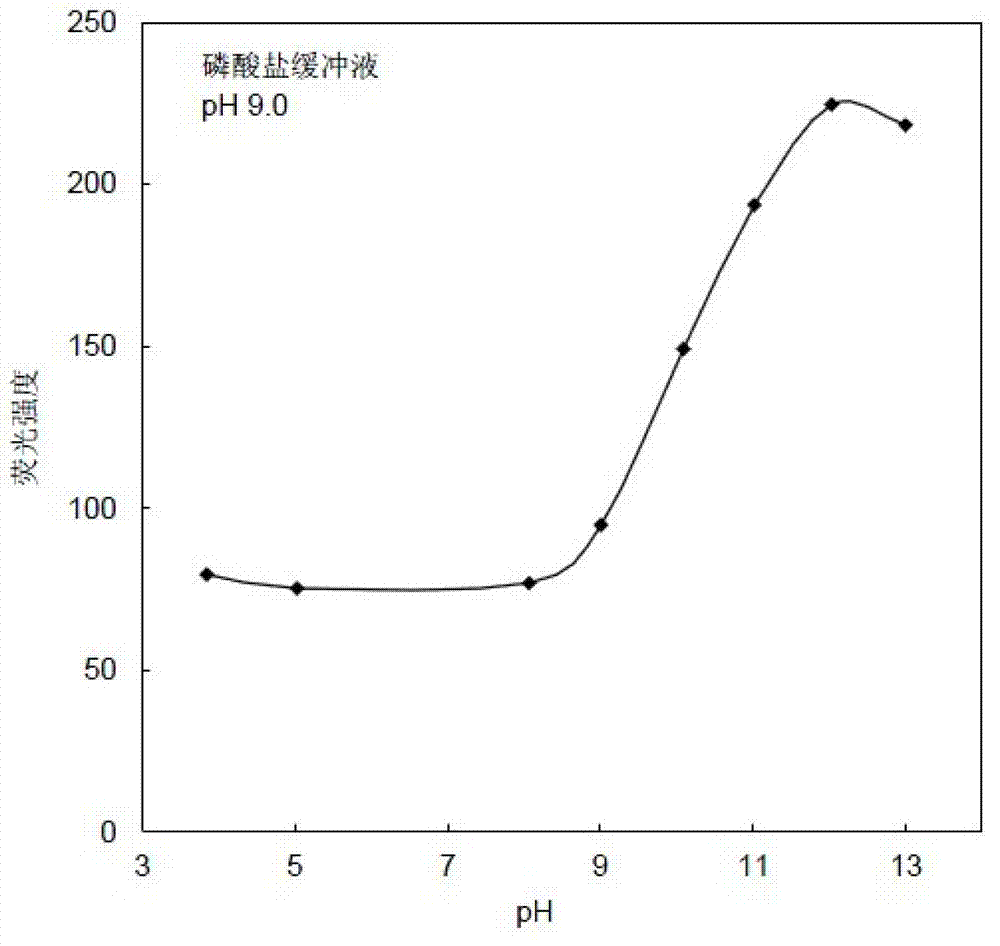Fluorescence sensing film based on boron dipyrromethene-phenyl boronic acid (BODIPY-PBA), preparation method and application thereof
A technology of fluoroboron dipyrrole and fluorescent sensing membrane, which is applied in the field of probes to achieve the effect of fast response time and good selectivity
- Summary
- Abstract
- Description
- Claims
- Application Information
AI Technical Summary
Problems solved by technology
Method used
Image
Examples
Embodiment 1
[0043] Example 1: Synthesis of BODIPY-PBA derivatives.
[0044] 1. Fluoroboron dipyrrole-phenylboronic acid is 8-phenylboronic acid pinacol ester-1,3,5,7-tetramethyl-4,4-difluoro-4-boron-3a,4a-diazepine symmetry Indacene (compound 2a) and 8-phenylboronic acid-1,3,5,7-tetramethyl-4,4-difluoro-4-boron-3a,4a-diazasymmetric indacene (compound 2b )Synthesis.
[0045] 13g (70mmol) of p-bromobenzaldehyde and 16ml (2.1eq) of 2,4-dimethylpyrrole and 50ml of dichloromethane were stirred under the protection of nitrogen under an ice-water bath. Trifluoroacetic acid was added dropwise, and the temperature was naturally raised to room temperature after the drop, and reacted in the dark for 6 hours. Add 16g (70mmol) dichlorodicyanobenzoquinone (DDQ) to continue the reaction for 2 hours, add dropwise N,N-isopropylethylamine (DIPEA) 90mL (7.0eq) and 100mL (7.0eq) boron trifluoride ether , Protected from light and reacted for 4h, the reaction mixture was washed with water, dried, and the so...
Embodiment 2
[0056] Example 2: Homogeneous detection.
[0057] Dissolve 1 μM compounds 2a, 2b, and 4b in ethanol, respectively, for the detection of optical properties, such as figure 2 shown. The emission wavelengths of 2a, 2b, and 4b are 510nm, 522nm, and 580nm, respectively. 2b was mixed with equal volumes of buffer solutions with different pH values to prepare 1 μM BODIPY-PBA for pH response detection, image 3 is the response of the 2b probe to pH, and the fluorescence intensity increases with the increase of alkalinity. The pKa of 2b is 10.1, which is higher than that of phenylboronic acid, mainly due to the influence of the structure of BODIPY 24 . In the BODIPY-PBA structure, since the BODIPY fluorophore and the intermediate substituted phenylboronic acid are perpendicular to each other, the two parts are separated. The trisubstituted boron atom is sp 2 The hybrid planar triangular structure, with empty p orbitals, enables boronic acid to accept electrons. It is obvious t...
Embodiment 3
[0060] Example 3: Preparation and detection of polymer optical sensor.
[0061] A fluorescent sensing film based on fluoroborate dipyrrole-phenylboronic acid, which includes the following components in weight percentage:
[0062]
[0063] The BODIPY-PBA selects compounds 2a, 2b or 4b, respectively.
[0064] The preparation method of the above-mentioned fluorescent sensing film based on fluoroboridipyrrole-phenylboronic acid: the formulation amount of fluoroboridipyrrole-phenylboronic acid, tridodecylmethylammonium chloride, polyvinyl chloride and 2-nitrobenzene Mix with n-octyl ether, dissolve in an organic solvent, mix thoroughly, apply a film evenly on the substrate, and dry it at room temperature to avoid light. The organic solvent is tetrahydrofuran (THF) or dimethylsulfoxide (DMSO). Wherein, the ratio of the added volume of the organic solvent to the total weight of fluoroborate dipyrrole-phenylboronic acid, tridodecylmethylammonium chloride, polyvinyl chloride and 2...
PUM
 Login to View More
Login to View More Abstract
Description
Claims
Application Information
 Login to View More
Login to View More - R&D
- Intellectual Property
- Life Sciences
- Materials
- Tech Scout
- Unparalleled Data Quality
- Higher Quality Content
- 60% Fewer Hallucinations
Browse by: Latest US Patents, China's latest patents, Technical Efficacy Thesaurus, Application Domain, Technology Topic, Popular Technical Reports.
© 2025 PatSnap. All rights reserved.Legal|Privacy policy|Modern Slavery Act Transparency Statement|Sitemap|About US| Contact US: help@patsnap.com



